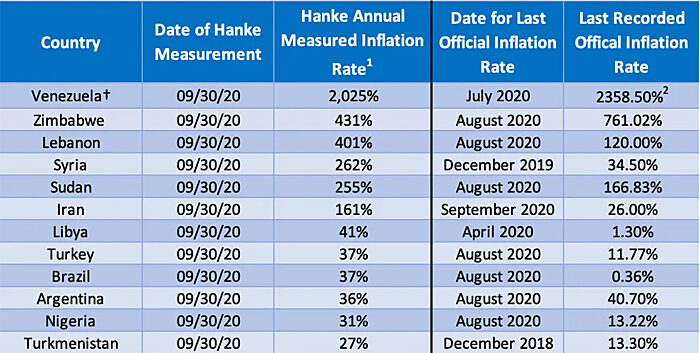Hanke Inflation Dashboard
Hanke’s Inflation Dashboard: The Media’s Misreporting on Hyperinflation
It’s clear that journalists and those they interview tend to play fast and loose with the word “hyperinflation.” How could this be?
The word “hyperinflation” is sprinkled throughout the press each day. We read that Iran is hyperinflating. The same is said of Zimbabwe and Venezuela, as well as a potpourri of other countries experiencing inflation flare ups. While Iran experienced a bout of inflation in the fall of 2012, it never reached the point of hyperinflation. And while Zimbabwe went through hyperinflation episodes in 2007-08 and 2017, it is not hyperinflating now. At present, Venezuela and Lebanon are the only countries on Hanke’s Inflation Dashboard (see below) that are going through hyperinflation. It’s clear that journalists and those they interview tend to play fast and loose with the word “hyperinflation.” How could this be?

As it turns out, many smart people pretend to know a lot about hyperinflation. Indeed, the media publishes interviews and statements from so-called experts, often economists and professors whose only knowledge of hyperinflation comes from what they read in the popular press and other news outlets. The result, as Casey Mulligan pinpoints (in a different context) in his recently released book, You’re Hired!: Untold Successes and Failures of a Populist President, is that “we end up with an echo chamber, or what I call a perpetual circle of fake news: the news outlets recite the experts, who repeat the news outlets, who recite the experts.”
As someone who has dealt with all the primary sources and replicated the calculations for every hyperinflation that has ever existed, I am well-placed to observe the perpetual cycle of fake news on hyperinflation as it rotates through the media. Indeed, barely a day goes by that I am not hit in the face with some false statement concerning hyperinflation.
To clean up the mess surrounding press reports on hyperinflation, we should pay attention to Eugen von Böhm-Bawerk, one of the founders of the Austrian School of Economics, who, in 1891, wrote, “We too must bring into our science a strict order and discipline, which we are still far from having. By a disorderly and ambiguous terminology we are led into the most palpable mistakes and misunderstandings — all these failings are of so frequent occurrence in our science that they almost seem to be characteristic of its style.”
Yes. Nothing cleans up ambiguity and disorder better than clear definitions. So, just what is the definition of the oft-misused word “hyperinflation?” The convention adopted in the academic literature is to classify an inflation as hyperinflation if the monthly inflation rate exceeds 50 percent. This definition was adopted in 1956, after Phillip Cagan published his seminal analysis of hyperinflation, which appeared in a book edited by Milton Friedman, Studies in the Quantity Theory of Money.
Since I use high-frequency data and Purchasing Power Parity theory to measure inflation each day in countries with significant price increases, I have been able to refine Cagan’s 50 percent per month hyperinflation threshold. With improved measurement techniques, I now define a hyperinflation as an inflation with a rate exceeding 50 percent per month for at least 30 consecutive days.
After years of research with the help of many assistants, I have documented, with primary data, 62 episodes of hyperinflation that are listed on the “Hanke-Krus World Hyperinflation Table,” with Lebanon being the most recent entry on the Hyperinflation Table.
Hungary holds down the top spot. Its peak hyperinflation occurred in July 1946, when prices were doubling every 15 hours. Zimbabwe’s November 2008 hyperinflation peak is second highest, but way behind Hungary’s. Indeed, at their peaks, the daily inflation rates were 207 percent in Hungary and 98 percent in Zimbabwe. Right behind Zimbabwe is Yugoslavia, which reached a peak inflation rate in January 1994, when the daily inflation rate hit 64.6 percent. Yugoslavia’s monthly inflation rate at that peak was a stunning 313 million percent per month.
While the most memorable hyperinflation is Germany’s, it only ranks as the fifth highest. It’s peak daily rate was 20.9 percent and its peak monthly rate was “only” 29,500 percent. This is way, way below the monthly rate of even just the third worst hyperinflation: Yugoslavia’s.
Now, let’s turn to the world’s highest, current hyperinflation: Venezuela’s. Venezuela has hyperinflated twice since 2016. Its first episode of hyperinflation, which ran from November 2016 to February 2019, ranks as the world’s 14th-most-severe episode, with a peak monthly inflation rate of 315 percent per month. While the magnitude of Venezuela’s first hyperinflation was relatively modest, it lasted for 27 grim months, which is the fifth-longest episode on record, with the longest being Nicaragua’s 58-month episode. Venezuela’s current episode, which started in April 2020, is still ongoing. Today, the annual rate of inflation is 2,074 percent per year.
When it comes to the media, I always embrace my 95 percent rule: 95 percent of what you read in the press is either wrong or irrelevant.
